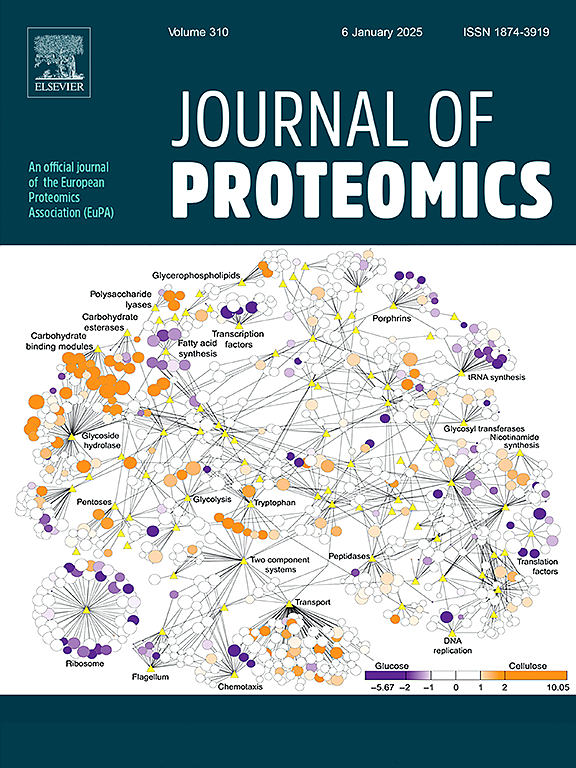干眼症小鼠角膜损伤治疗机制的蛋白质组学分析
IF 2.8
2区 生物学
Q2 BIOCHEMICAL RESEARCH METHODS
引用次数: 0
摘要
干眼病(DED)是一种常见的眼表疾病,影响全球数百万人。临床和实验研究表明,中药清玄润目饮(QXRMY)治疗DED有效。本研究旨在探讨DED角膜损伤的分子机制,并评价QXRMY的治疗效果。将120只C57BL/6小鼠分为对照组、DED模型组和QXRMY治疗组。角膜组织DIA测序鉴定出2411个差异表达蛋白。富集分析显示这些蛋白参与RNA聚合酶II调控、细胞凋亡和蛋白磷酸化。KEGG通路分析强调了PI3K/AKT、HIF-1信号通路和细胞骨架调控在QXRMY作用中的关键作用。FL、BUT、Schirmer I试验、HE和PAS染色证实了DED的角膜损伤和QXRMY的修复作用。ELISA结果显示QXRMY可显著降低IL-1β、IL-6和TNF-α水平,提示具有抗炎作用。PCR和Western blot进一步证实QXRMY通过PI3K/AKT/HIF1α通路修复角膜损伤。本研究为DED的发病机制提供了新的见解,并支持QXRMY通过减轻炎症和促进角膜修复治疗DED的治疗潜力。本文章由计算机程序翻译,如有差异,请以英文原文为准。

Proteomics analysis of the mechanism of the treatment of corneal injury in dry-eye mice
Dry eye disease (DED) is a common ocular surface disorder affecting millions globally. Clinical and experimental studies have shown that the traditional Chinese medicine formula Qingxuan Runmu Yin decoction (QXRMY) is effective in treating DED. This study aimed to explore the molecular mechanisms of corneal damage in DED and evaluate QXRMY's therapeutic effects. A total of 120 C57BL/6 mice were divided into control, DED model, and QXRMY treatment groups. DIA sequencing of corneal tissue identified 2411 differentially expressed proteins. Enrichment analysis revealed these proteins were involved in RNA polymerase II regulation, apoptosis, and protein phosphorylation. KEGG pathway analysis highlighted key roles of the PI3K/AKT, HIF-1 signaling pathways, and cytoskeleton regulation in QXRMY's effects. FL, BUT, Schirmer I tests, HE, and PAS staining confirmed corneal damage in DED and the repair effects of QXRMY. ELISA showed QXRMY significantly reduced IL-1β, IL-6, and TNF-α levels, suggesting anti-inflammatory properties. PCR and Western blot further confirmed QXRMY repairs corneal damage via the PI3K/AKT/HIF1α pathway. This study provides new insights into the pathogenesis of DED and supports QXRMY's therapeutic potential in treating DED by alleviating inflammation and promoting corneal repair.
求助全文
通过发布文献求助,成功后即可免费获取论文全文。
去求助
来源期刊

Journal of proteomics
生物-生化研究方法
CiteScore
7.10
自引率
3.00%
发文量
227
审稿时长
73 days
期刊介绍:
Journal of Proteomics is aimed at protein scientists and analytical chemists in the field of proteomics, biomarker discovery, protein analytics, plant proteomics, microbial and animal proteomics, human studies, tissue imaging by mass spectrometry, non-conventional and non-model organism proteomics, and protein bioinformatics. The journal welcomes papers in new and upcoming areas such as metabolomics, genomics, systems biology, toxicogenomics, pharmacoproteomics.
Journal of Proteomics unifies both fundamental scientists and clinicians, and includes translational research. Suggestions for reviews, webinars and thematic issues are welcome.
 求助内容:
求助内容: 应助结果提醒方式:
应助结果提醒方式:


